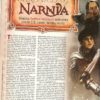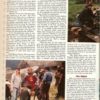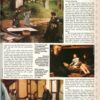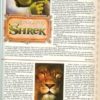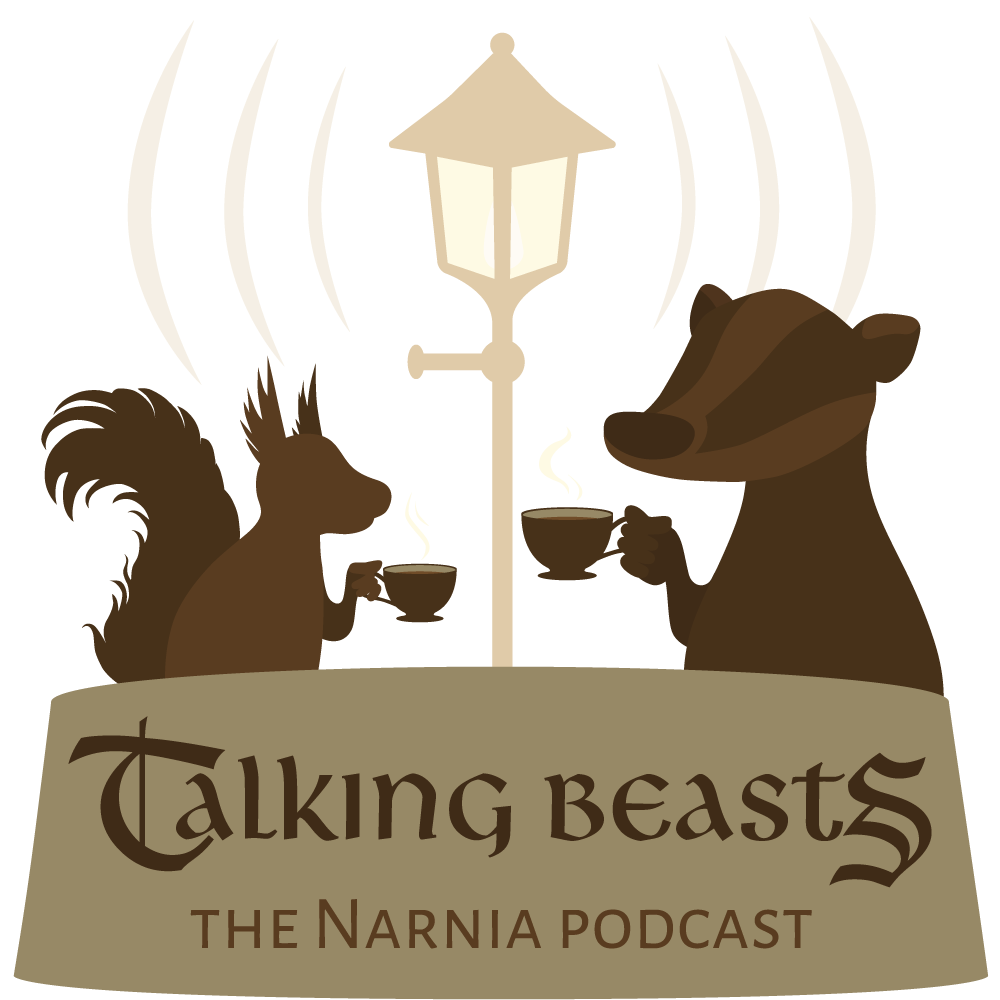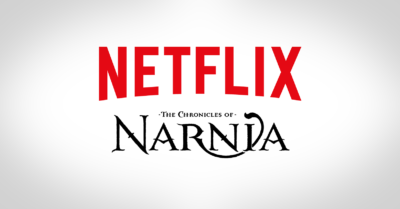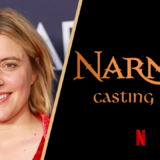Starlog Chats to Andrew Adamson
Starlog Magazine has conducted a lengthy interview with Andrew Adamson about the development and filming of The Lion, the Witch, and the Wardrobe, including audience reactions. You can read our transcription below. Thanks to Rachelavonlea for sending in the article.
Chronicling Narnia: Director Andrew Adamson welcomes you to C.S. Lewis’ fantasy world.
The Edwards Cinema-12 movie theater in La Verne, California is more intense than usual on this Wednesday night during the waning days of summer. In the neon-lit lobby you can’t help but notice that every top Walt Disney executive – including then CEO Michael Eisner – is standing there, trying to read viewers’ faces as they leave an advance screening of the Disney/Walden Media big-budget adaptation of C.S. Lewis’ The Chronicles of Narnia: The Lion, the Witch, and the Wardrobe (which premieres December 9).
The story of children who come to the Land of Narnia to help a mystical Lion overthrow a Witch who rules by fear is the studio’s first attempt to make something along the lines of The Lord of the Rings, so their nervousness is palpable. As is their joy – which increases as positive comment cards and happy viewers begin trickling out of the theater. Some kids are wiping away tears, so moved were they by Aslan the Lion.
Wearing a crisp white button shirt and shoulder-length hair that gives him a casual resemblance to the Mighty Thor, director Andrew Adamson is pleased to hear teens, parents, and especially kids excitedly talking about his film. “It’s interesting when you’re at a screening with children, because you can tell when they’re engaged in the story by how vocal or quiet they are,” he smiles. “There were moments when I realized I couldn’t hear any popcorn bags! The other fun thing at a screening like this one is when you see a kid running for the toilet. You know you’re in good shape then because they’re trying not to miss anything!”
Three weeks later, Adamson (who co-directed the Shrek films) is almost done applying the finishing touches to his fantasy epic. “I read the Narnia books when I was about 8 years old, and they stuck in my head,” he explains. “Both my older brother and I were huge fans, but when Disney initially came to me with the property, I was a little reluctant for two reasons. One: I didn’t want to modernize it, I wanted the film to be true to the period and faithful to the novel, and I expected they would ‘adapt’ it heavily. And two: I didn’t want to do anything on this scale. Coming off the Shrek movies, I was thinking about doing a little character piece, but I couldn’t turn Narnia down because it’s just too special to me. It has existed in my consciousness for 30 years, so I couldn’t resist it!”
Did he ever ask himself why he was making his live-action debut with one of the most popular book series ever, featuring a cast that includes lions, kids, witches and monsters? “Yeah, I did think about that,” he laughs. “I thought about it every day! I considered that before I took on the project, and that was one of the reasons I was a little hesitant to begin with. There’s a ton of pressure and so many expectations. At the same time, I dealt with considerable expectations on Shrek 2, so I said, ‘Why the hell am I knocking myself? Just jump into it!’
‘But I was definitely scared, because this project is such a big task,” he adds. “It involves many different elements, including a classic book that’s very dear to a large number of people. The fear of screwing all that up was quite legitimate. However, I figured if you’re gonna do something that’s original and fresh, you have to go into that zone. You need to be working with that anxiety, because if you aren’t, you probably aren’t doing anything that’s risky enough to be worthwhile.”
Comparing the experience of directing a live-action film to a CG-animated picture, Adamson remarks: “I don’t think live action is any harder, and emotionally it’s the same. You go through the same ups and downs, although the process is different. In animation, lots of things go on over a period of time, but live action is more gut-instinct and instantaneous. In animation, you can concentrate on the actors individually, but what you don’t get is the performers sparking off each other or being in the environment, which you get for free in live action. That’s both positive and negative. Still, I would say the experience is similar. One of the differences is, in live action, you don’t have to tell your actors when to blink. But in animation, you don’t have to worry about weather. So it all balances out.”
Aslan the Lion is one of the most important characters in the story. “The movie hinges on two things: one is a realistic portrayal of Aslan, and the other is the kids,” Adamson says. “I’ve always had a fondness for animals, particularly large cats, and I think that comes from Aslan. So I wanted to make sure he was done right, and I spent a lot of time with real lions on this. That was a dream come true, because I got to play with and pet and spend quality time with them.’
‘I was determined that Aslan be completely ‘photo real’. I didn’t want people saying, ‘Oh, that’s a cool CG lion!’ He needed to be believable and possess the awe and fear that a real lion inspires, because that’s why Lewis put a lion in that role. It’s an attraction-repulsion thing: People are drawn toward lions, but they’re also terrified of them. That’s a very strong omnipotent leader quality. We actually started the research and development on Aslan about three years ago.”
Liam (Batman Begins) Neeson provides the voice of Aslan, who has a gentle nature but is capable of wrath-of-God anger. “The great thing about Liam is that he’s both,” Adamson says. “He’s very gentle and compassionate with the kids, but he’s also capable of real force and threat. Liam gives Aslan both those traits. He’s a physical presence with a big, booming voice, but he’s a warm and caring man as well.”
Reportedly, Brian (X2) Cox was originally slated to play Aslan. “He was,” Adamson confirms, “and we started developing the character with him, but for a number of reasons – mostly that we didn’t have Aslan figured out yet – it was mutually decided that we weren’t where the character needed to be. So I rethought and recast the part with Liam, who does an amazing job.”
The crucial parts of the Pevensie children weren’t filled by big-name young actors. Instead, Georgie Henley is Lucy, William Moseley plays Peter, Skandar Keynes essays Edmund, and Anna Popplewell is Susan. “I cast according to the kids’ personalities, rather than their acting ability,” Adamson notes. “I was looking for kids who kind of were the characters, which would make things easier because they could be themselves a bit more. Although we did change some stuff along the way; when we saw certain traits and how the kids delivered [their lines], we would say, ‘That’s a strength. Let’s capitalize on that!’
‘Within the story, the kids change and grow, and I really fleshed them out and made them more three-dimensional than they are in the book. In the novel, Edmund is simply a bad boy who does something to get food, Turkish Delight. I wanted to make it deeper – and it’s there in the book, you just have to look beneath the surface. Why is Edmund bad? They’re in the middle of WWII, the father is probably away, the mother is involved in the war effort, and the children are being shipped off to the country … How is that going to affect this kid? Suddenly, his big brother is taking the place of his father and telling him what to do, and Edmund is feeling resentment.
“The White Witch doesn’t just offer Edmund Turkish Delight; she offers him position over his brother – and that is in the book,” Adamson adds. “She tells him, ‘I’m going to make you the King of Narnia and your brother can be a Duke or something.’ It comes down to Edmund making a more personally driven decision and not being so one-note. All of the characters have that level – of scratching below their surface to see what’s really going on inside them.”
Tilda (Constantine) Swinton stars as the villainous White Witch. “From the moment I started on this project, I wanted Tilda to play her,” Adamson says. “Her physical stature and appearance are perfect for the part, and I’ve always loved her as an actor. Orlando is an amazing film, and Tilda naturally intelligent and sophisticated person. I really didn’t want the Witch to be the stereotypical ‘evil woman’, because the White Witch was not a cliche when Lewis wrote the book, although H. Rider Haggard created that sort of character first with Ayesha (in She).
‘Since then, that [wicked female role] has become a cliche, with Cruella De Vil, the evil step-mum and those kind of harsh, nasty women. I wanted to get away from that cliche, and I knew Tilda would have the same instinct. To some degree, your protagonists are only as good as your antagonist, so I had to be sure the White Witch was believable, real and cold – but not conventionally – evil.”
For the scenes where Aslan faces down the White Witch, “Liam wasn’t on set to do his lines, so it was quite often up to me to be Aslan. I enjoy delivering off-screen dialogue because I can shift the performance around to change the other actors’ performances without direction. I can alter the delivery and they’ll respond differently; it’s almost like improv. So sometimes Aslan was just me sitting there off-camera, because it gave the actors somebody to play off of. Other times, it was either a big polystyrene creature, an animatronic lion or what we call a ‘stuffy’, which is a big stand-up.”
Adamson was born in Auckland, New Zealand. “But I grew up and spent most of my formative teenage years in Papua New Guinea, up in the tropics,” he says. “I came back to New Zealand when I was about 18, intending to go into architecture, but I was in a car accident and missed the enrollment. Instead, I ended up getting into computer animation, just because a job came up that looked interesting.’
‘I’ve been around computers my entire life. My father was in computing from the advent, so it was all familiar territory to me. Computer animation combines art and science the same way architecture does, and that led to me getting a job in the U.S. doing commercials, station L.Ds and flying logos. That was right around the time that PDI got into film, and I started working on a movie called Toys that was, ironically, produced by Mark Johnson. That shows how strange a circle life is, because Mark is now producing Narnia! Toys made me realize what I wanted to do in life, which is tell stories longer than 30 seconds. So I went toward directing, one step at a time, working on many different films.”
He even spent some time in Gotham City. I was on Batman Forever and Batman & Robin,” he says. “They were fun visual effects projects and gave me the joy of creating worlds, because we built Gotham City from the ground up and imagined whole environments. I really enjoyed that aspect on both of these films and tried to do that on Shrek. To some degree, I also used that on Narnia — because it’s such a fantastic universe and one I got to dream up like a big child.”
When discussing The Chronicles of Narnia, it’s hard not to mention The Lord of the Rings and how director Peter Jackson’s film trilogy may have influenced or affected Adamson’s adaptation of Lewis’ novel. “I actually asked Peter, whom I know fairly well, ‘How faithful were you to the Lord of the Rings books?’ because the movies were touted as being very loyal. He replied, ‘Interestingly enough, we changed a lot, but that’s fine as long as [the film] is good.’ That was great advice and reassuring to me. It made me realize that people will accept changes if they’re good changes.’
‘We had a small city built in the middle of the south arm of New Zealand, about two hours out of Christchurch. There were 100 people in prosthetics and battle gear who required computer augmentation later. That sequence was technically difficult and physically demanding. But some of the intimate scenes were tough, too — like when the little girl had to tear up and cry in a very emotional moment. We were working with an either-year-old child who’s an extraordinary actor, but we were on this huge green-screen stage with 100 people around. Other times, we were in a tent out in a field being hit with howling winds, trying to pull off these emotional scenes in trying circumstances.”
Another obstacle is that many kids — and some adults — probably have no idea what a wardrobe is. “That’s true,” Adamson chuckles. “I’ve heard people say, ‘Y’know that scene where they go through the closet?’ No, there is no closet! It isn’t even an armoire!” But enough people will know, and it’s such an evocative image anyway. The idea of opening a secret door and finding a secret world that no one else knows about has as much universal appeal as monsters under the bed.”
Prince Caspian is Lewis’ sequel to Wardrobe. In fact, the author penned seven Narnia novels. So if this film is a success, Adamson could be living in Lewis’ fantasy world for the next decade or so. “I’m certainly not going to direct all seven of them,” he remarks. “We’ll find out if the studio wants to do another one, but we’re setting this up as an ongoing story. I just can’t think too much about [possible sequels] because I would be overwhelmed if I did. Right now, I’m in survival mode, just going through Wardrobe. There’s so much involved between the visual FX, scoring, color correction … and my wife gave birth yesterday! The idea of doing another movie right now makes me think, ‘What are you, crazy?!?’ I’m sure after a great night’s sleep, my thoughts will change.”
That’s right, while making an epic, FX-laden family adventure film, the director’s wife was expecting. “You can’t really schedule a baby’s arrival,” a tired Andrew Adamson grins. “Sylvie is our second girl. I did not pick a name from Narnia — although I really like the name Lucy. But I just could not do that. It would have been too weird. I would have had to call my next kid Donkey or something!”

